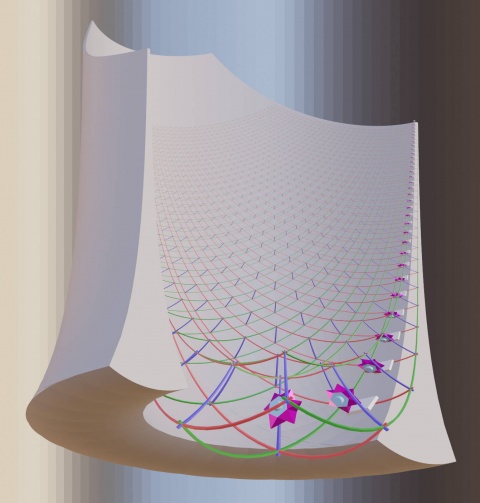Distorted visualization methods for convergent assembly

To get a complete picture of the physical layout of all the assembly levels of the convergent assembly in a nanofactory (which might be organized in a stack of coplanar layers) and see all of this in one single image at one glance one needs to project space in a nonlinear way.
Normal perspective (a linear projection) is unsuitable since it compresses most details towards the horizon.
Instead a nonlinear polar logarithmic mapping is the best fit.
An additional difficulty is that a nanofactory as opposed to a map is inherently three dimensional so some cross cut has to be chosen. Whether that cross cut can be simply planar or not depends on the exact design choices taken in a concrete nanofactories design.
(wiki-TODO: add image [1] -- license?)
Contents
Displaying many scales and their relation simultaneously
This can be done by generalizing log polar mapping to 3D like so:
- x'(x,y,z) = pi/2 - atan2( z, sqrt(pow(x,2) + pow(y,2)) ) * cos(atan2(y,x)))
- y'(x,y,z) = pi/2 - atan2( z, sqrt(pow(x,2) + pow(y,2)) ) * sin(atan2(y,x)))
- z'(x,y,z) = log( sqrt(pow(x,2) + pow(y,2) + pow(z,2)) ) / log(base)
Related
Distorted visualization methods (like e.g. the 3D log polar mapping visualization method) may also be useful to keep oriented in the visualizations of
abstract spaces other than concrete physical space. E.g. circuitry topology in very large software systems.
- More generally: Visualization methods for gemstone metamaterial factories
- Challenges in the visualization of gem-gum factories
- Visualizing the stratified nanofactory layers or other geometries that implements assembly levels.
- Showing only what is needed at anyone time. Related: The software interface principle of "progressive disclosure".
- Drifting off-topic: General software issues
Hyperbolic geometry and Escher disks
Related to this: https://en.wikipedia.org/wiki/Circle_Limit_III
Problem #1:
Not all scales are treated the same. More precisely:
The mapping does not transform scale invariance into translational symmetry (as log polar does).
Infinitely big things get crunched into finite space. A singularity at the perimeter. Even when exponentially/geometrically growing.
(Not sure if you can explode the rim when growing uber expeonentially with an essential singularity, doubt so even then, fascinating math problem but beside the practical focus here.)
Problem #1: The depiction is inherently 2D.
Vertical cut:
Projecting to an Escher disk a vertical cut through exponentially growing assembly levels with bottom at the disks center
this would give only the top half of a disk. Above the center shrinking down the growing size layers but soon too much.
Sideways already small things get shrunk down too pointlessly.
So overall not a particularly good choice for a coordinate transformation.
Horizontal single plane cut through already log polar transformed coordinates:
This gives a disk looking similar to an Escher disk but it would be very different in nature.
Transforming a planar disk from log polar back to original coordinates gives an spherical (half)shell.
With exponentially shrinking assembly levels nearing the xy-plane there is much stuff compressed to near the edges of the disks.
Well limited by the smallest assembly level of course as we have physics not pure math.
This is really not suitable for showing thinsg at multiple scales simultaneously.
Also note that the observation angle within a deisk changes like on a sphere as well in the original coordinates we are on a sphere
(nonequidistantly sampled sphere to highlight peculiarity).
External Links
- Wikipedia on log polar mapping: Log-polar coordinates
- Wikipedia on the Mercator projection which becomes log polar near both poles: Mercator projection
- An interactive online map spanning a wide range of scales: mercator extreme
The mercator projection cut off much closer to the poles whichs location can be freely chosen.
- python scripts to generate log-polar maps from pixelgraphics [2]
- "Detail-In-Context Visualization for Satellite Imagery" [3]
"Complex Logarithmic Views for Small Details in Large Contexts" [4]
by Joachim Boettinger et. al.
Department of Computer and Information Science, University of Konstanz, Germany - Video showing a manual multi-scale zoom device [5] the "zoom-scope"
- square grid mapped to show details on all scales equally [6]
- More large scale map examples [7]
Keywords
distortion lens view; log-polar map; complex logarithmic map, complex logarithmic view, anamorphic mirror, anamorphosis
